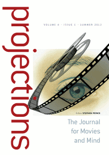
Projections-The Journal for Movies and Mind
Scope & Guideline
Decoding the Cultural Impact of Cinematic Narratives
Introduction
Aims and Scopes
- Cognitive and Psychological Analysis of Film:
The journal emphasizes studies that investigate how films affect cognitive processes, emotions, and psychological responses in viewers, often employing methodologies from neuroscience and psychology. - Philosophical Inquiry into Cinema:
It includes explorations of philosophical themes related to film, such as the nature of cinematic experience, moral implications, and the aesthetic dimensions of moving images. - Ethics and Social Implications of Film:
Research addressing the ethical dimensions of filmmaking and the societal impact of cinematic narratives, particularly in terms of representation and audience engagement. - Interdisciplinary Approaches to Film Studies:
Projections encourages contributions that integrate various fields such as media studies, cultural studies, and technology to provide a holistic understanding of film's role in society. - Narrative and Aesthetic Structures in Film:
The journal explores narrative complexity, stylistic elements, and the aesthetic appeal of films, examining how these factors contribute to viewer engagement and emotional responses.
Trending and Emerging
- Neuroscience and Film:
There is a growing trend in research that examines the relationship between neuroscience and film studies, investigating how brain activity correlates with cinematic experiences and viewer engagement. - Cognitive Film Theory:
The journal increasingly features studies that apply cognitive science to film analysis, exploring how cognitive processes shape viewer interpretation and emotional responses to narratives. - Affective Engagement and Viewer Experience:
Research focusing on the emotional and affective engagement of viewers is on the rise, with studies examining how films evoke specific emotional responses and the implications for long-term viewer engagement. - Ethical Considerations in Film:
Emerging themes include the ethical responsibilities of filmmakers and the societal effects of film narratives, particularly in relation to representation and audience impact. - Interactivity and New Media:
As digital media evolves, the journal is beginning to explore themes related to interactivity in film and media, particularly how new platforms influence viewer experience and engagement.
Declining or Waning
- Traditional Film Theory:
While foundational film theories were once prevalent, there is a noticeable decline in papers that strictly adhere to classical film theory, as the journal increasingly embraces cognitive and psychological frameworks. - Historical Analysis of Film Techniques:
Research centered on historical perspectives of film techniques and technologies is becoming less frequent, as contemporary studies focus more on cognitive and emotional responses rather than technical evolutions. - Generic Film Criticism:
The journal appears to be moving away from conventional genre analysis and criticism, favoring more nuanced explorations of viewer engagement and emotional implications over strict genre categorizations.
Similar Journals
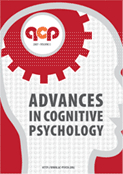
Advances in Cognitive Psychology
Illuminating the Pathways of the MindAdvances in Cognitive Psychology is a premier peer-reviewed journal published by UNIV ECONOMICS & HUMAN SCIENCES WARSAW, dedicated to the exploration of psychological processes underlying cognition. With its open access model implemented since 2005, the journal facilitates wide-ranging dissemination of cutting-edge research across various branches of psychology, including applied, clinical, experimental, and cognitive psychology. Despite its modest standing in terms of impact factor, reflected in its Q3 and Q4 rankings across numerous subfields, it remains an important platform for emerging researchers and seasoned professionals alike, aiming to foster insight into complex mental processes and enhance understanding of behavioral patterns. The journal's commitment to accessibility empowers a diverse community of readers, including students, to engage with innovative studies and reviews, contributing to the collective knowledge within the psychological sciences. Located in Poland, Advances in Cognitive Psychology is open for submissions from worldwide researchers, encouraging a global perspective on cognition and behavior.
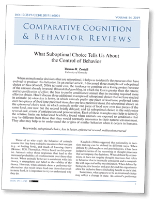
Comparative Cognition & Behavior Reviews
Exploring the depths of animal behavior and cognition.Comparative Cognition & Behavior Reviews is a leading open-access journal, published by the Comparative Cognition Society, dedicated to advancing the interdisciplinary field of comparative cognition and behavior. Since its inception in 2006, this journal has become a crucial platform for researchers, professionals, and students alike in the fields of animal science, ecology, and veterinary studies. With an increasing impact on understanding cognitive processes across species, it features diverse articles that explore the evolutionary, ecological, and psychological dimensions of behavior. The journal is particularly notable for its Q3 ranking in Animal Science and Zoology, and Ecology, Evolution, Behavior and Systematics, as well as a Q2 ranking in Veterinary (miscellaneous). Based in Canada, it aims to disseminate high-quality research while allowing free access to its content, fostering a wider dissemination of knowledge. With its continuous growth and commitment to excellence, Comparative Cognition & Behavior Reviews is poised to play an increasingly vital role in shaping the future discourse on cognition and behavior in the animal kingdom.

BRITISH JOURNAL OF AESTHETICS
Cultivating Rigorous Research in Aesthetic StudiesBRITISH JOURNAL OF AESTHETICS is a prestigious academic publication focusing on the diverse and intricate field of aesthetics and philosophy. Published by Oxford University Press, this journal has established itself as a leading platform for scholarly discourse since its inception in 1960, boasting an impressive Q1 ranking in Philosophy for 2023. With its commitment to publishing rigorous research and critical analyses, it addresses essential questions encountered in contemporary aesthetic thought, making significant contributions to both theoretical and practical dimensions in the field. While the journal is not open access, its subscription-based model ensures high quality and peer-reviewed content that serves researchers, professionals, and students eager to explore and engage with cutting-edge ideas and discussions in aesthetics. With an extensive archival depth projected through to 2024, BRITISH JOURNAL OF AESTHETICS remains an invaluable resource for anyone committed to the advancement of aesthetic knowledge.
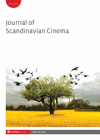
Journal of Scandinavian Cinema
Celebrating the Rich Tapestry of Scandinavian CinemaThe Journal of Scandinavian Cinema, established in 2014 and published by INTELLECT LTD, serves as a premier platform dedicated to the interdisciplinary field of film studies with a specific focus on Scandinavian cinema. With an impressive Q2 category ranking in Visual Arts and Performing Arts for 2023, and a Scopus rank placing it in the top 62nd percentile of its category, this journal is instrumental in advancing scholarly dialogue within the arts community. The journal strives to explore and critique cinematic expressions from the Nordic countries, contributing to a nuanced understanding of cultural narratives and filmic innovations. Committed to fostering accessibility and engagement, it caters to a diverse audience including researchers, professionals, and students keen to delve into the artistic, cultural, and political dimensions of cinema. The Journal of Scandinavian Cinema is essential for anyone interested in the evolution and impact of film in the Scandinavian context, promising rich insights and a robust collection of scholarly articles.
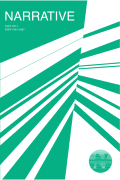
NARRATIVE
Illuminating the Intersection of Story and SocietyNARRATIVE is a distinguished academic journal published by Ohio State University Press, focusing on the intricate dimensions of literature and literary theory. Established in 2002, this journal has quickly risen to prominence, currently ranking first quartile (Q1) in its field according to 2023 metrics, and securing an impressive percentile of 94th among 1106 journals in Arts and Humanities. With its ISSN 1063-3685 and E-ISSN 1538-974X, NARRATIVE is committed to exploring the narrative structures and processes that shape our understanding of both literature and broader cultural phenomena. Although it does not offer open access, NARRATIVE proudly contributes to academic discourse by publishing articles that challenge, inform, and inspire scholars, professionals, and students worldwide. The journal continues to be an essential platform for innovative research and critical analysis, fostering dialogue at the intersection of storytelling, identity, and societal context.

MUSIC PERCEPTION
Advancing Understanding Through Auditory InsightsMUSIC PERCEPTION is a prestigious academic journal dedicated to the interdisciplinary exploration of musical experience and understanding. Published by the University of California Press, this journal has established itself as an essential resource in the field of music psychology, with a strong emphasis on how auditory stimuli influence human cognition and emotion. The journal boasts a commendable Q1 ranking in Music, placing it within the top-tier of scholarly publications, and it holds an impressive Scopus Rank of #4 out of 180 in the Arts and Humanities category, reflecting its critical role in advancing research within this domain. MUSIC PERCEPTION welcomes contributions that delve into diverse topics, including auditory perception, acoustics, and the psychological impacts of music, making it a vital platform for researchers, professionals, and students seeking to deepen their understanding of music's multifaceted nature. The journal is published annually and remains a cornerstone for academic discourse, ensuring that new findings are readily accessible to a global audience.

Cine Documental
Illuminating Narratives Through the Lens of DocumentaryCine Documental is a prominent academic journal dedicated to the exploration of documentary cinema, encompassing a wide range of topics from historical analyses to contemporary critiques and theoretical frameworks. Published by CINE DOCUMENTAL, this journal provides an essential platform for researchers, filmmakers, and enthusiasts in the field of film studies, particularly focusing on the vital role that documentary plays in reflecting and shaping societal narratives. With an ISSN of 1852-4699, Cine Documental invites contributions that engage with both traditional and avant-garde documentary forms, fostering dialogue and innovation within the discipline. Although currently not operating under an open-access model, this journal is committed to maintaining a rigorous peer-review process, ensuring the quality and relevance of published works. Located in Buenos Aires, Argentina, and catering to a global audience, Cine Documental stands as a significant contributor to the advancement of film scholarship, making it an invaluable resource for students, academics, and professionals alike.

Cahiers de Narratologie
Advancing the Discourse of Narrative TheoryCahiers de Narratologie is a distinguished academic journal dedicated to the study of narratology, published by the Laboratoire Interdisciplinaire Récits, Cultures, & Sociétés (LIRCES). Since its inception in 2001, this Open Access journal has provided a vital platform for researchers, scholars, and students to explore and disseminate knowledge on narrative theory and its multifaceted applications across various disciplines. With a commitment to fostering interdisciplinary dialogue, Cahiers de Narratologie features rigorously peer-reviewed articles, critical essays, and innovative research that delve into the complexities of narrative structures, practices, and effects in contemporary culture. As an essential resource for understanding the intersection of storytelling and cognition, this journal plays a significant role in shaping the field and supporting scholarly discourse on narratives. The journal is based at UNIV NICE-SOPHIA ANTIPOLIS, in the picturesque region of NICE, FRANCE, and continues to attract contributions from a global network of narrative researchers.
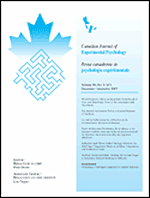
CANADIAN JOURNAL OF EXPERIMENTAL PSYCHOLOGY-REVUE CANADIENNE DE PSYCHOLOGIE EXPERIMENTALE
Connecting Minds: Bridging Research and PracticeCanadian Journal of Experimental Psychology / Revue canadienne de psychologie expérimentale (ISSN 1196-1961, E-ISSN 1878-7290), published by the Canadian Psychological Association, serves as a vital resource in the fields of Experimental and Cognitive Psychology and general psychological research. With a respectable impact factor that places it in the Q3 category for both Experimental Psychology and miscellaneous Medicine (2023), this journal offers a platform for innovative research that furthers our understanding of psychological processes. Spanning years from 1993 to 2024, it connects researchers, professionals, and students to contemporary findings and methodologies, fostering a collaborative environment for the advancement of psychological science. Though it does not currently offer Open Access, the journal's commitment to quality and relevance in psychological research continues to make it an important part of the academic landscape, supporting the dissemination of knowledge within a global community.

Short Film Studies
Advancing Scholarship in Brief Film NarrativesShort Film Studies is a leading journal dedicated to the exploration and analysis of short films, published by INTELLECT LTD. Since its inception in 2014, this esteemed journal has carved a niche within the realm of Visual Arts and Performing Arts, providing a critical platform for scholars, practitioners, and enthusiasts alike to engage with the unique characteristics and cultural implications of short film as a distinct medium. Despite its current position in the Q4 quartile, the journal is steadfast in its commitment to enhancing scholarly discourse and understanding in this dynamic field. With a growing repository of research, Short Film Studies aims to bridge theoretical insights with practical examination, facilitating a deeper appreciation of cinematic innovation. Its accessibility through conventional channels underscores its significance, should you wish to engage with cutting-edge research and trends. As a vibrant component of the academic landscape, this journal promises valuable contributions that resonate with researchers, professionals, and students pursuing knowledge of filmic artistry.